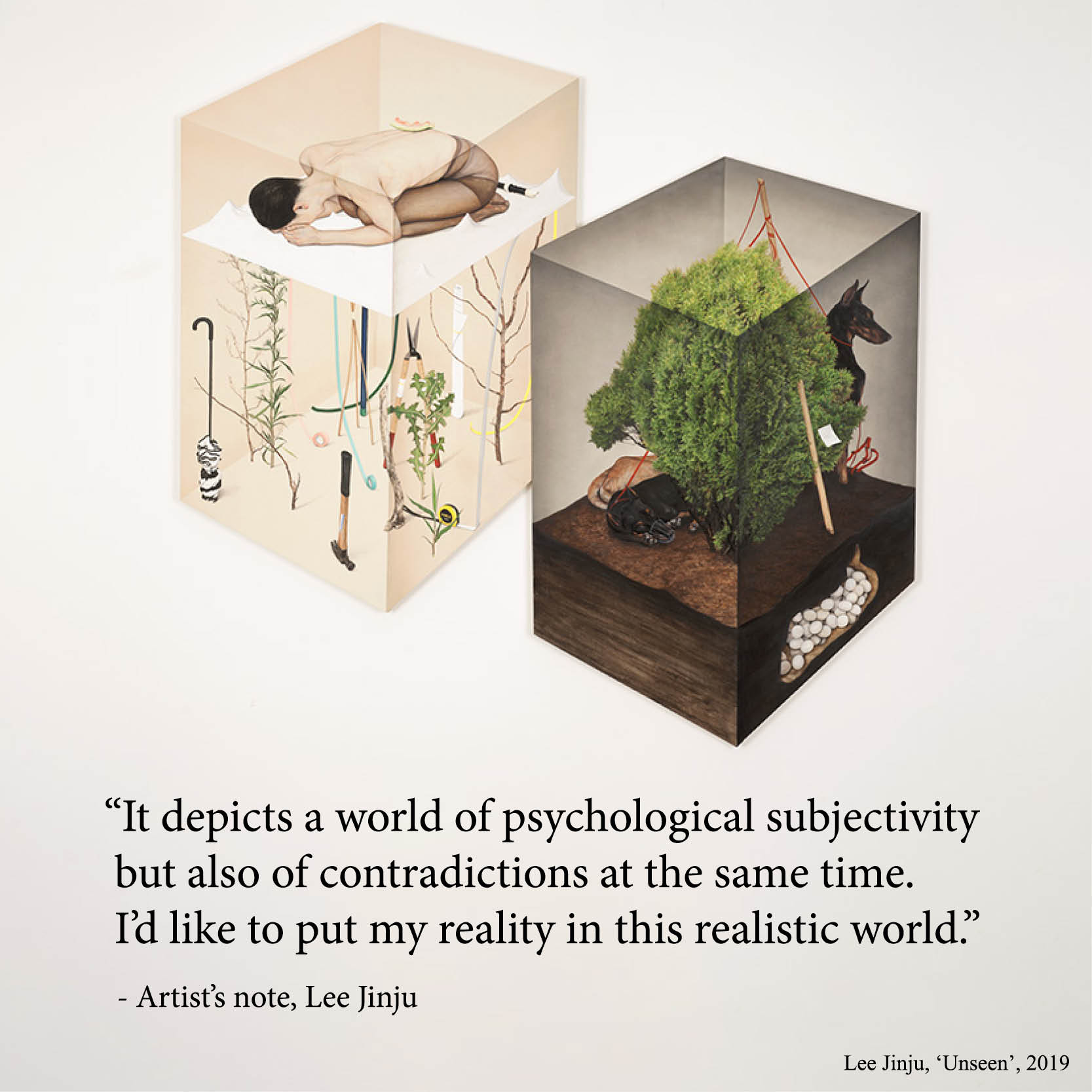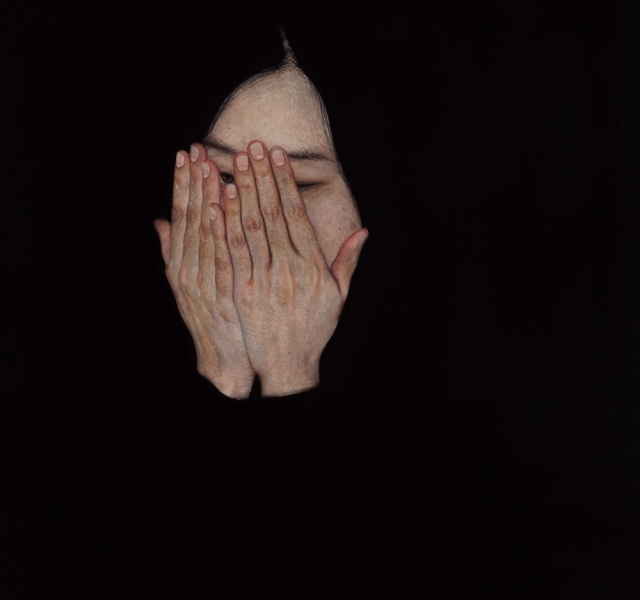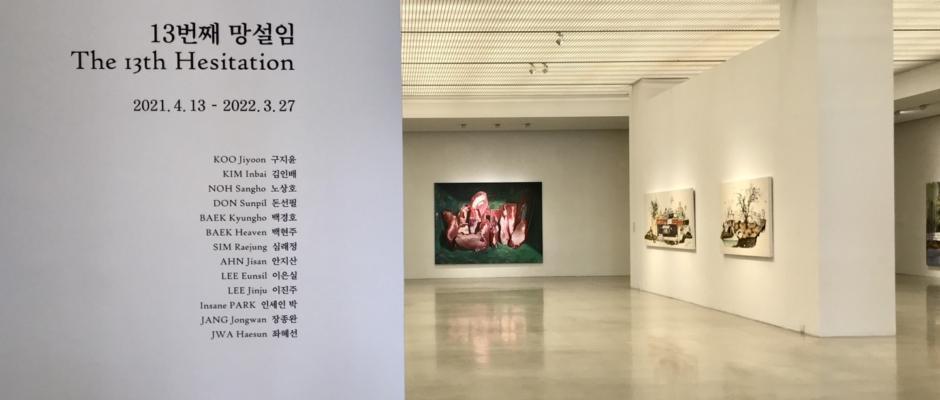Nonprofit_Exhibition
Korean Contemporary Artists Who Intersect with the "Past. Present. Future.": 17 Artists, Including Kim Jipyeong and Lee Jinju, at SONGEUN
April 18, 2022
A Team
“Past. Present. Future”. is SONGEUN Art and Cultural Foundation’s first special exhibition in 10 years that highlights its collection. The selected collections in the exhibition span centuries, from traditional ancient art from the Goryeo Dynasty (918–1392) to NFT (non-fungible token) works by living contemporary artists under the theme of “time.”
 Title image of "Past. Present. Future." SONGEUN. Seoul. April 6 - May 14, 2022. © SONGEUN Art and Cultural Foundation.
Title image of "Past. Present. Future." SONGEUN. Seoul. April 6 - May 14, 2022. © SONGEUN Art and Cultural Foundation.
The exhibition attempts to overlap and cross different times, rather than following the flow of time that goes in one direction from the past to the future. The works of 17 contemporary artists intersect with the past and future to look into the current contemporary art culture and reexamine the foundation and vision for the direction of their collection.
The artworks also reflect how the institution’s supporting artists have met their art and foresee how these emerging artists picture the future art world.
Among the 17 artists, Kim Jipyeong and LEE Jinju, two of the artists participating in K-ARTIST.COM, an online platform operated by Aproject Company, are featured in the exhibition to introduce their artistic practices and how they regard the traditional as an inspiration.
 Artists Kim Jipyeong and LEE Jinju. Courtesy of the artists.
Artists Kim Jipyeong and LEE Jinju. Courtesy of the artists.
Artist Kim Jipyeong (b. 1976) talks about contemporary issues by using traditional objects called Janghwang (粧䌙), which are made of silk or thick paper, such as picture books, scrolls, and folding screens. In the past, these objects were denied as fine art and marginalized by mainstream art forms.
Kim does not interpret these traditional art forms from a contemporary perspective but rather interprets the present in the context of the past. In other words, she contemplates the society of today by deliberately creating anachronistic works.
Kim brings up the stories of today by using traditional art forms, concepts, and history that has been neglected in traditional Asian visual cultures, such as marginalized female artists, shamanic ritual paintings, or Buddha and Bodhisattva paintings that have long been devalued as fine art and various arts that are only left in records.
 김지평 (Kim Jipyeong) '능파미보 凌波微 步 숙선 , 호연재 , 옥봉 , 매창 , 사주당 , 금 원 , 청창 , 난설헌 , 운초 , 빙허각'. 10 폭 병풍 : 나무틀에 한지 , 비단 , 혼합재료 장식 180 x 450 cm 2019
김지평 (Kim Jipyeong) '능파미보 凌波微 步 숙선 , 호연재 , 옥봉 , 매창 , 사주당 , 금 원 , 청창 , 난설헌 , 운초 , 빙허각'. 10 폭 병풍 : 나무틀에 한지 , 비단 , 혼합재료 장식 180 x 450 cm 2019
© SONGEUN Art and Cultural Foundation and the Artist. All rights reserved.
Artist Lee Jinju (b. 1980) borrows techniques from traditional Korean painting to draw her memories as psychological landscapes. The landscapes and objects realistically depicted in detail in the paintings are those that we easily encounter in our daily life, yet the overall scenery somewhat gives the viewers an uncanny and surreal sense.
Memory is not bound by the flow of time or the logic of space. Time does not flow in the same direction in memories; it can be fragmented, divided into pieces, and sometimes reversed. Thus, the landscape of Lee’s memory lacks logical continuity. This is also the case with space. Within the canvas, the artist depicts confined spaces that are sometimes divided into several parts and where objects defy gravity, creating new scenes and stories that cannot be understood at once.
Memories can settle deep in one’s subconscious, be forgotten, and even get distorted. Just as these deformed pieces of memories can form a new narrative when they come together, Lee also attempts to depict these new unfamiliar scenes in her works.
 이진주(LEE Jinju), '4 의 견해' 천에 채색 67 x 340 cm 2014 © SONGEUN Art and Cultural Foundation and the Artist. All rights reserved.
이진주(LEE Jinju), '4 의 견해' 천에 채색 67 x 340 cm 2014 © SONGEUN Art and Cultural Foundation and the Artist. All rights reserved.
Founded in 1989, the SONGEUN Art and Cultural Foundation is an institution that aims to introduce to the public both Korean and international contemporary art by supporting young Korean contemporary artists and inviting lesser-known international artists to the country for holding various exhibitions throughout the year.
 Exterior view of SONGEUN Cultural Foundation. Photo by Aproject Comapny.
Exterior view of SONGEUN Cultural Foundation. Photo by Aproject Comapny.
The foundation established the SONGEUN Art Award program in 2001 and holds call-for-artist programs for young artists at SONGEUN Art Cube in Daechi-dong, Seoul. SONGEUN Art Space, the main exhibition space, first opened in 2010 and moved to a new building in Cheongdam-dong in 2021.
Articles
























